China
China has changed a lot. Like a giant that moves at a lightning speed. And changes its own self. Like a chameleon! It was always a giant. The chameleon thing started only about thirty years ago.
China is an ancient society. The common man has been oppressed here for the last two thousand years. The Chinese Royalty and the Aristocracy controlled the wealth, the means of production and tried very hard to convince the hungry masses that the only way to avoid death from starvation was to work hard to create more wealth for their masters. The elegant Chinese architecture, the culture, the arts and the literature were unknown and inaccessible to the poor.
This history is not much different from what happened in the West and in South Asia, but the Chinese did it with style. They had an elaborate system of government administrators and educators that went hand in hand to stifle the poor. The tax collectors were all over the country, the law enforcement ready to send people to jail for minor infractions. The educators made sure that education was not accessible to the poor – heck, the Chinese alphabet has 5000 characters and it takes about five years to be literate in Mandarin. After five years, you are in the first grade (class 1) in school! A farmer’s child will hardly have time to learn the alphabet, he would be better off to start work at the age of ten! Even basic literacy was a privilege for the rich! Shame!
Granted, the abovementioned history of China is naïve representation of a very complex set of events in a vast country, but the relentless poverty of the poor has been a self-sustaining fact for a millennium. The communist government that came into power had some good intentions initially, but soon found that socialist policies do not work in a stodgy bureaucratic society. The government started lying about its achievements and torturing the populace as well, just as it happened in other communist countries.
A few important contributions of the Communist regimes came in very handy in the subsequent era of state capitalism. The socialist state of Mao could not figure out how to run a factory or a small store efficiently because of the all-pervasive bureaucracy, but it built schools and hospitals everywhere even in remote areas of china. From zero literacy of the poor till 1950, China achieved a high overall literacy rate as early as the 1970’s.
The government also forcefully liberated women. Women went to the same schools and worked the same jobs as men, and even wore the same clothes in Mao’s China! In fact sometimes everyone wore the same clothes, even the same color!
Liberalization and reforms happened in the late eighties –the history of that is complicated as well. By early nineties, the Chinese government, in association with the budding capitalists, had a brilliant business idea.
If you build factories in remote hinterlands of china, you will get unemployed laborers who barely survive in agriculture – they will be willing to work for about $5 a day (400 rupees). Then you can make simple consumer goods – pens, coffee cups, toys, spoons and forks, cheap clothes and shoes – for about half the cost of anywhere else in the world. The trick is to control quality, build infrastructure to support large manufacturing facilities, and raise productivity of workers.
The bulldozers and the heavy construction equipment of the government went to work . Massive factories were built in hitherto unknown cities which were close to supply sources of minerals, fuel and water. Train tracks and highways were built fast, blazing all the land and small villages that were in the way, blasting through mountains and building bridges over rivers. Thanks to Mao’s regime, even the piss poor in villages were literate, so they can be gainfully employed in factories. In a few short years, the Chinese were selling everything for consumers in every country of the world, from hairpin for your hair to the belt for your waist and shoelaces for your shoes!
This was so damn successful that it led to other huge projects as the capitalists became bolder and a solid middle class was created in a few short years with a much more sophisticated labor force. The economy took off, major projects were undertaken to transform old cities and build new ones, all with the brute force of an all powerful government. The Chinese economy , singlehandedly, caused factories to shut down all over USA and Western Europe and elsewhere!
Fast forward to 2017 when I visited China. By now, the factories have exhausted the excess supply of labor from the remote villages. Minimum wage for factory jobs is more like $4 (300 rupees) an hour, still low by Western standards but a major improvement for the standard of living for the common laborers (from 500 rupees a day to 2400 rupees per day!). China now outsources many products to Cambodia, Bangladesh, Indonesia etc. where wages are lower. The Chinese are now into the production of more sophisticated products like electronics, cars, phones and computers. The higher educational sector has expanded many times over, with spanking new universities and joint ventures with famous American and European institutions. The average salary for a young college professor was about $500 a month in the early nineties, now about $5000 per month ( $3500 after taxes- about 2.6 lakhs- –taxes are high in China!). You can live lavishly with a family in China with that salary – no bribes need to be taken, no secondhand payments , no corruption!
In USA, in our university, there were PH.D. students from all over the world but none from mainland china until the early 90’s. The students that trickled in in the early nineties had no intention to go back to China. Nowadays, many go back to work in China after finishing their education.
My colleague in Kansas, Dr. Jin, grew up in a village in China and came to USA in the late eighties, one of the first batch of students who were allowed to apply to foreign universities by the Chinese government. He got his Ph.D. from a prestigious US university and started working at the university of Kansas in the early nineties. Over the years , we became friends. Here is a pic of us destroying a lot of Chinese food in America in 2019, the last time I went to USA .
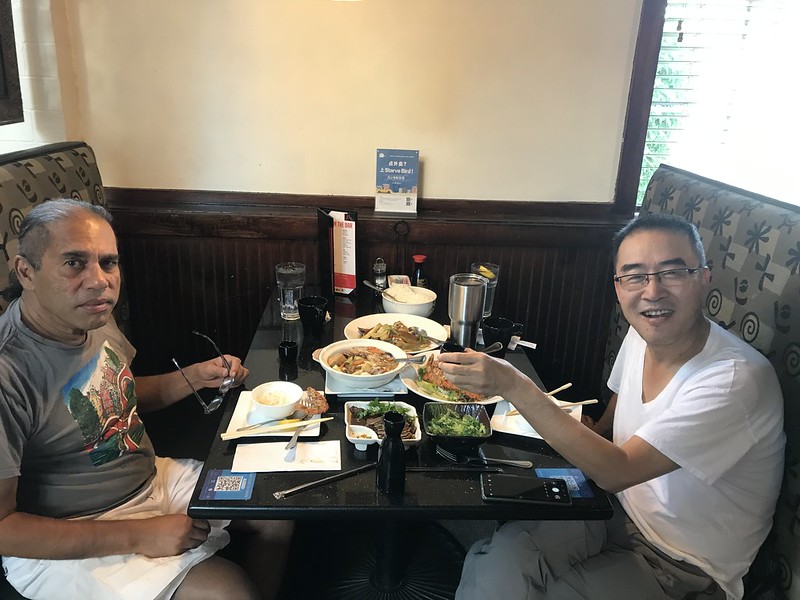
Jin goes back to China every year for three months or more. We often talked about my visiting him. For about ten years prior to 2014, it never worked out – I always taught summer courses and then went to India to visit my mother. Then in 2014, I moved to Almaty, Kazakhstan and for the first time in my life took a semester off in the Fall of 2017. This meant that I had time off from May 15, 2017 to January 3, 2018 – a long break indeed.
The travel deal was set up with Dr. Jin. I will fly to Beijing from India in late July 2017 and surrender to Dr. Jin. He will drive his car and take an eight day vacation around Beijing to places that he wanted to visit. I will tag along with him.
There were pros and cons of this plan:
The pro was I was getting a local guide with great knowledge of the local culture and history, we can also discuss economic aspects of China’s development among ourselves.
Also, my guide already set up the full itinerary, and I was going to special places that foreigners rarely visit.
The con was that I had to miss some important tourist sites that everyone sees in Beijing! For instance, I did not see the Great Wall. Overall, I think it was a great deal for me!
Dr J picked me up at the airport and took me to a hotel that was part of the Olympic village (during the Beijing Olympics). The hotel was OK, but the location was next to a beautiful lake next to a mountain. I had my first of many delicious meals in China in a standard roadside restaurant. It was Chinese hot pot, with beef pork and veggies, to be cooked by the customers at the table. They put a simmering fire pot in the middle of the table and a pot of spiced broth on fire, we put thinly sliced meat and veggies in the broth, they get cooked in a few minutes, and we eat them with noodles or rice. I had this before in America in Deluxe Chinese places, but in China, it is very common. Look at the pic below:

The noodles are already in the broth in the middle of the table, there are three plates of beef and pork and two plates of veggies (you can choose chicken or fish if you wish). And yes, I can eat with chopsticks! Price was reasonable.
Came back to our hotel, relaxed by the lake for a while and in the evening I got my first taste of Chinese affluence. The entire mountain across from the lake, about one kilometer wide, was lit up with beautiful illumination.
I asked Jin if there is a festival going on.
No, he said the lighting is provided by the government for the hotel guests to enjoy.!
See the pic below:
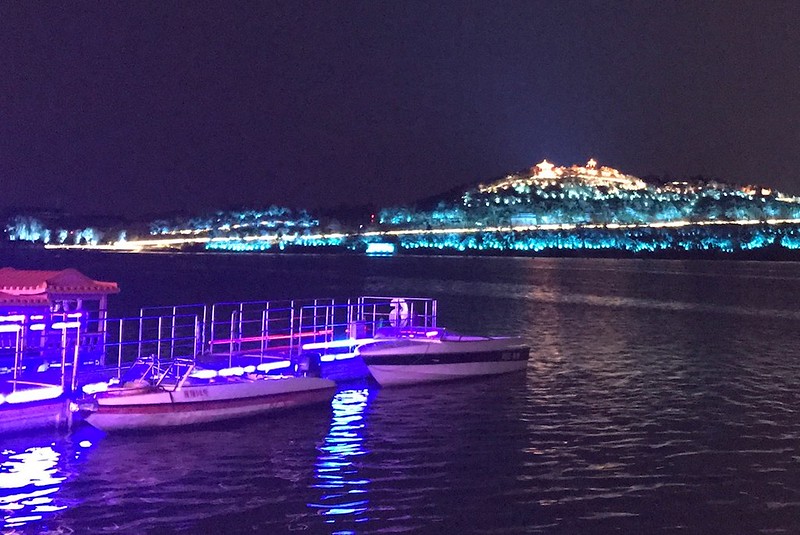
There is absolutely nothing on the mountains except trees, it is not a town that is being lit up, just some empty space! All for the enjoyment for a few hotel guests!
This being my first day in China, I was a little confused about what to make of this. Later I saw many other examples of conspicuous extravagance by the government and understood the implications – it is BIG government showing off to the puny citizens its affluence and its power! – The message is somewhat sinister, indeed!
The next day, we met up with two Chinese women who finished their Ph.D’s in USA and have returned to work in Chinese universities as professors – Jin knew them from his own university in China, they both wanted to meet a senior economist (me) who had done research in their specialty area.
Apart from our professional discussion, the main activity was to visit the Emperor’s Palace, also called the Forbidden City. It was actually closed to the public until the communist revolution – now there is a big mural of Mao at the entrance, the inside is unchanged. This is one of the two premier tourist spots in China (the other being the Great Wall which I did not visit). A tip for you, the iconic Tienmien Square is now a very large parking lot in front of the palace, not worth visiting unless you want to see rows of parked cars.
The Imperial Palace was a sight to behold, it is actually a large number of palace- like buildings for the emperor and his offices and living quarters , several times bigger than the Red Fort in Delhi. I was impressed with many dragons, evidently an integral part of the Chinese culture.
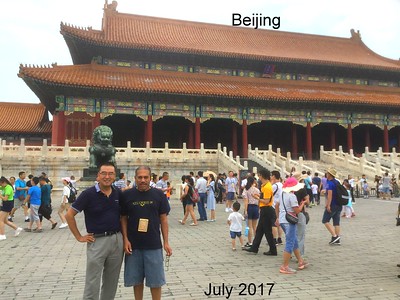
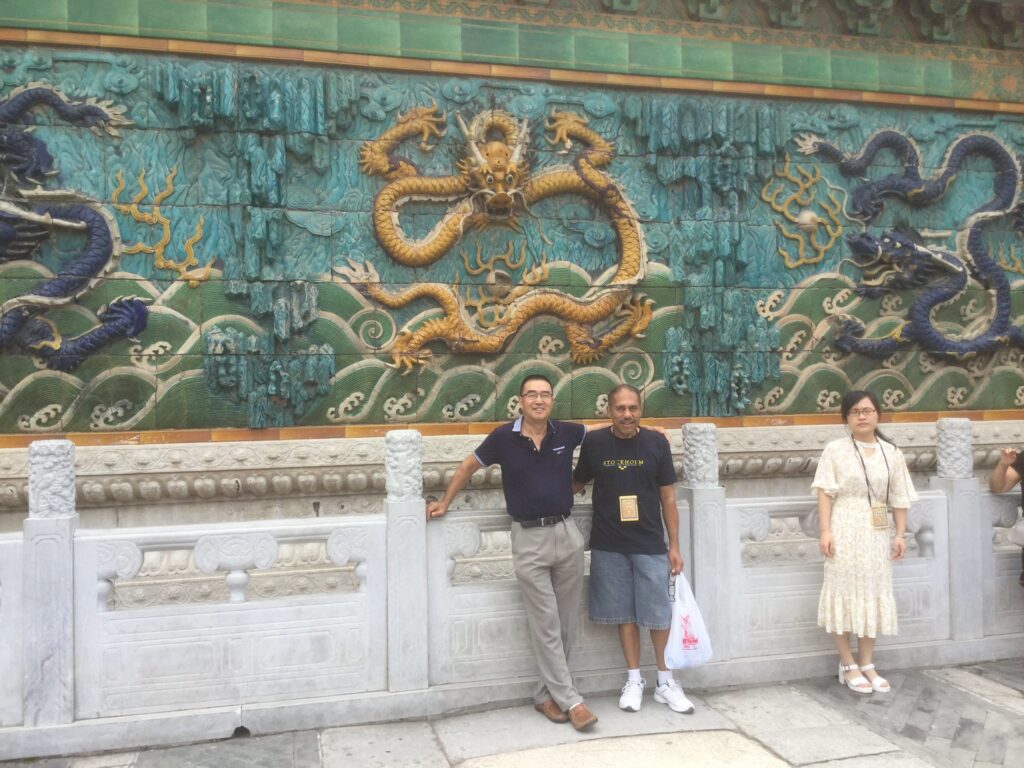
Apparently, there are good dragons, bad dragons, lucky dragons and evil dragons – I don’t know which is which!
Let’s do a digression on the status of women and family in China. The Communist regime adopted a one child policy, it has been in place for about 60 years now. Around the same time, the communist government sent women to work, same as men. They were even asked to wear the same clothes as men, the infamous Mao tunic. As a result, several generations of women became educated and independent ,erasing the earlier stereotype of women as homemakers.
The communists forced out gender discrimination but bought forth a somewhat androgynous society for a couple of generations. These women, growing up, had no access to make up, hair care products or nice clothes or shoes or beauty parlors. I mean, not poor women, but ALL women, about 500 million of them! Being feminine was deemed as sexualization and it reeked of Western debauchery! Dr. Jin dated his would be wife from high school, they got married after six years of dating. He would tell his daughters , who were born in USA, about the only time he saw his wife in a nice dress with make up and styled hair and high heels was on his wedding day. Even after coming to USA, Ms. Yang, his wife, never dressed up, she really had no fashion sense. She would come to all our faculty parties wearing jeans and an over-sized shirt just like her husband.
Continuing on this theme, my new economist friends turned out to be well-educated, articulate and friendly. They were in the prime of their lives, with a Ph.D. in hand and very good jobs. Yet, they both complained, half-jokingly, about how difficult it is to get a nice Chinese husband. They both appeared to have no regard for fashionable or feminine clothing.
However, I am happy to report that this androgenic behavior is also changing fast. The last batch of Chinese Ph.D. students in Kansas around 2014 when I left ( those women would be about ten years younger than the women above) were more”American” in appearance, more confident and apparently they all had nice Chinese boyfriends! And by 2011 or so, a new generation of rich Chinese kids had started infiltrating USA campuses, not as Ph.D. students on scholarship, but as undergraduates paying big money from their dads. These kids have fantastic knowledge of English and most of the young women are absolute eye candies, and dressed like it too! I would keep my office door wide open when these girls visited me during my office hours and ask the visitors to sit far away from me!! Yea Man!
The following day, Jin said, we will meet with about six people , families of Economics and finance professors, and we will do exciting things outside of Beijing. There was some confusion in the morning about the meeting, we drove around for a while trying to locate each other. I was looking for traditional Chinese neighborhoods in Beijing but did not see any, Then it hit me: the Chine neighborhoods that we saw in books and pictures 30 years ago , are all gone. Jin confirmed this, Take a look below at typical Chinese boulevard:
The following is a sideways view of the street. The top side is the right side. Please note that in China, driving is on the right side of the street. The bottom part is the left side .
Please read the following like this: At the extreme right, there are multi-storied skyscrapers. On the left of the skyscrapers , there is a pedestrian walkway. To its left there is a divider with grass and flowers. To its left, there is a bicycle path , and so on! – you get the idea!!
Multi-storied skyscrapers
_________________________________________________________________________________
Pedestrian walkway (footpath)
Median ( grass and flowers)
Bicycle path
Median (divider )
Feeder road for cars that exit the main road
Median –this one has large trees usually
← Main road for traffic going one way ←
Median
_____________________________________________________________________________
→ Main road for traffic going the other way →
Median
Feeder road
Median
Bicycle path
Median
Pedestrian Walkway
Multi-storied skyscrapers
All the shops are at the bottom floors of the sky scrapers, sometimes there is a strip mall next to the feeder road.
You may have seen 50 to 100 meter wide roads like this in a few planned cities in India or in the West. In Beijing, ALL the roads are like this! There are no side streets, no poor neighborhoods, no narrow streets, no small old houses, no congested areas, no slums! Over the last twenty years, bulldozers came into old Chinese neighborhoods with their lanes and bylanes, congested main roads, small older houses and random shopping corners. They razed and destroyed them all and the streets like in the previous page were built, along with large city parks, playgrounds, canals and small lakes in EVERY neighborhood!! Only a few old neighborhoods are preserved as “old Beijing” for people to visit and reminisce.
What about the people that were evicted? They were allocated apartments in the newly built skyscrapers , sometimes with an additional monetary compensation. Did they agree to be moved? Were they happy with the relocation? The Big Government did not care! The new city of Beijing has a lot less old time charm than the old one. To compensate for this, the government built fountains , statues and gardens and impressive light displays on the new roads and on the skyscrapers. The old factory worker who would look at dirty laundry hanging from the neighbor’s balcony in front of his old dilapidated home , can now look at this massive illumination over a park in front of his apartment on the 20th floor. Is he happier there? You tell me!
Let’s compare old Beijing and new Beijing Streets:
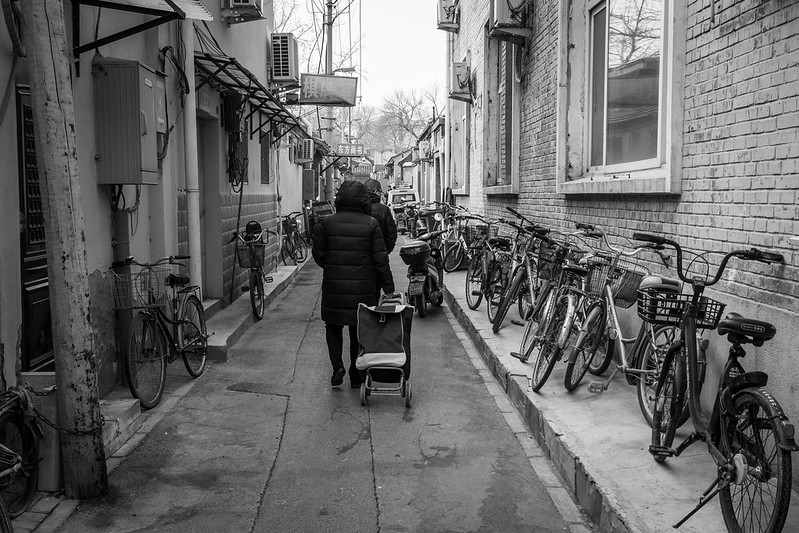
Only a few streets like this exist, retained mainly for nostalgic purposes. – internet photo, sorry!
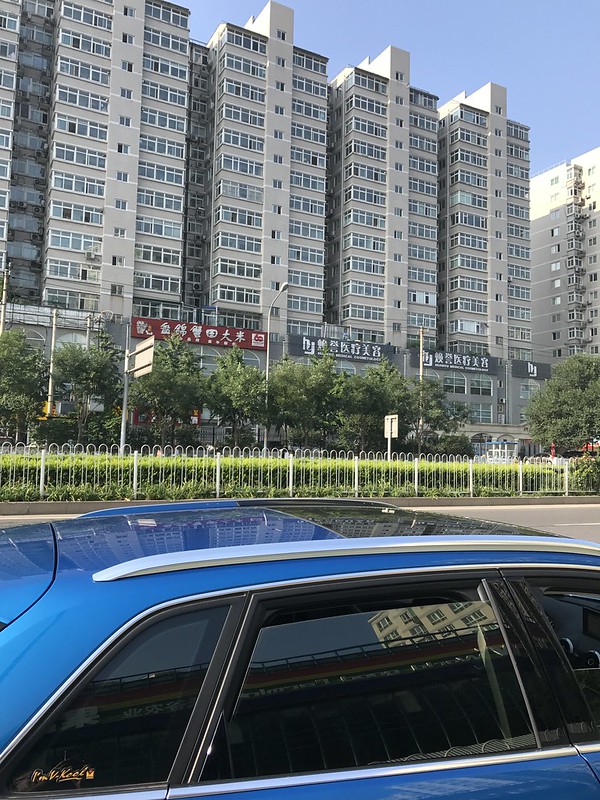
Photo taken from the right side of a brand new street.
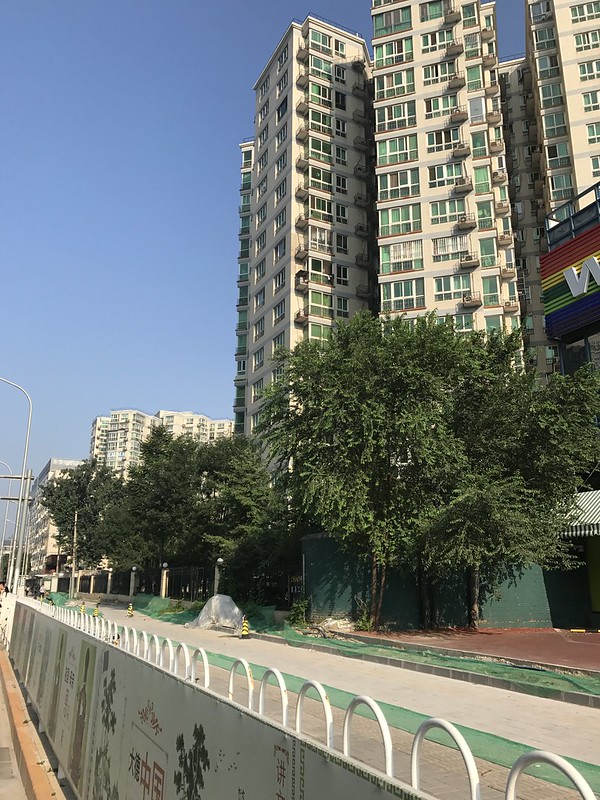
The above pic was taken from the main road. On the right hand side, you can see the pedestrian sidewalk, the bicycle path and the feeder road, as well as the medians.
Lets finish the first Part here. The next day, we go out of Beijing to try some other brand new stuff.

The article seems to have been written through the eyes of the traveller, Gautambabu. A comparative study is welcome from him why Indians fail behind the Chinese ecomomy in spite of area, population and other economic potentials in India. Why chinese people were forced to limit their families having one-two children for longer periods by their ruling governments? What are the palpable effects of cosmetic & non-cosmetic make-ups adorned by the chinese females on their economy? What are about Maoism working still there including the great leaps of ecomomic develpments taken place after him from Den Xiao Ping? Has Shi Fin made aberrations from them? What about the genocide of the Tibetians and ther future? A little knowledge about the Sino-Indian border and Hindi Chini Bhai Bhai impasse are welcome in this article. What about Wyghurs? We of course know India and China are two great Asian nations with ancient civilisations. On which particular ECONOMIC counts , the Indians fail and are failing still now?
Dear Apurba babu
Thanks for your comments. I am not competent enough to answer all of your questions. I will answer a couple of them partially in a separate blog.
Gautam
Thanks and Regards to Gautambabu for writing the article.
Finished a fat book called Wild Swans by Jung Chang this year – so was really interested in your narrative. The book was such an eye opener for me – the horrendous things that happened to that family! And they were communists, party members! One thing – I think there was some gap between the emancipation of women, and the one child policy. Chang’s parents had 5 kids! The parents were administrators, the children were looked after by wet nurses, grandparents etc.. Reading that book, I felt that women were emancipated in some ways, but not all.
About the thing worn by the woman you met – I think its a backpack vest, not a shirt with a backpack?
Madhumati
Thanks for your comment. The book by Jung Chang (which I have not read) deals with the Maoist era when there was no “one-child” policy. the policy came into being around 1980, after an tentative two-child policy from 1970-80. In any case, women have been encouraged to work and study in china since the inception of the communist regime, although the family hierarchy remained traditional. Only with the enforcement of the one-child policy, the traditional role of the women has been changed, because both parents pushed their only child to succeed and prosper professionally, and not as a housewife! Again, emancipation is a relative term , and in every country, post-emancipation social structure is different.
Dissent, as described by Jung Chang, was not tolerated in Mao era, it is hardly tolerated now.
The woman with a backpack is wearing a removable vest with a backpack in front – a poor fashion choice indeed. After some reflection, I decided to delete this pic and the ensuing discussion about their clothing. I did not want to appear as a fashion enforcer anyways.
Thanks again
Gautam